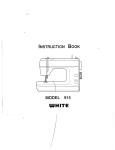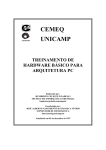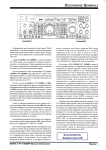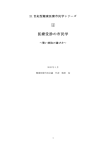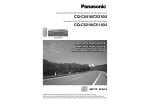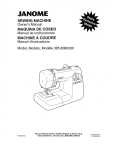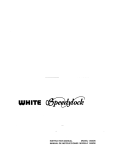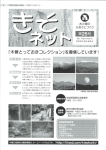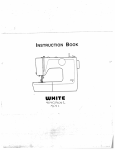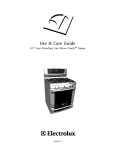Download White 1425 Instruction manual
Transcript
INSTRUCTION BOOK j MODEL 1 1425 WHITE POLARIZED PLUG CAUTION To reduce the risk of electric shock, this appliance has a polarized plug (one blade is wider than the other). This plug will fit in a polarized outlet only one way. If the plug does not fit fully in the outlet, reverse the plug. If it still does not fit, contact a qualified electrician to install the proper outlet. Do not change the plug in any way. SEWING MACHINE Record in space provided below the Serial No. and Model No. of this appliance. The Serial No. is located Rear of arm. The Model No. is located Rear of arm. Serial No. Model No. 1425 Retain these numbers for future reference. Foot Controller Model YC482E for use with sewing machine Model 1425 This sewing machine is for home use. English IMPORTANT SAFETY INSTRUCTIONS o osj .iu loctrical appliance, basic safety precautions should always be followed, including the following: Read all instructions before using (this appliance). To reduce the risk of electric shock: OANGER — — A qphoo:o ;tiould never be left unattended when plugged in. Always unplug this appliance from the electric outlet immediately oid bifore cleaning. ini WARNING — — To reduce the risk of burns, fire, electric shock, or injury to persons: I to be used as a toy. Close attention is necessary when this appliance is used by or near children. 1’. li .ijplcince only for its intended use as described in this manual. Use only attachments recommended by the manufactur nnrct in this manual. .-r i’ r porite this appliance if it has a damaged cord or plug. if it is not working properly, if it has been dropped or damaged, or lipped into water. Return the appliance to the nearest authorized dealer or service center for examination, repair, electrical or 4 Novor - st llow ittoii:aJ Idlustrnent. pwate the appliance with any air openings blocked. Keep ventilation openings of the sewing machine and foot controller frt, from the accumulation of lint, dust, and loose cloth. 1 Never drop or insert any object into any opening. Do oat use outdoors. I Do not operate whore aerosol (spray) products are being used or where oxygen is being administered. it To disconnect, turn of i inplriq all controls to the off(”O”) position, then remove plug from outlet. by pulling on cord. To unplug, grasp the plug, not the cord. DANGER 1 2 Always unplug before relamping. Replace the bulb with same type rated 15 watts. I )o riot reach for irn appliance that has fallen into water. Unplug immediately. Do not place or store appliance where it can fall or be pulled into a tub or sink. Do not place or drop into water or other liquid. English WARNING the sewing machine needle. d Keep fingers away from all moving parts. Special care is require around break. to needle the can cause plate Always use proper needle plate. The wrong Do not use bent needles. causing it to break. Do not pull or push fabric while stitching. It may deflect the needle in the needle area, such as threading needle, changing nee ents adjustm any Switch the sewing machine off (‘0”) when making dle, threading bobbin, or changing presser foot, etc. removing covers, lubricating, or when making any other user ser 6. Always unplug sewing machine from the electrical outlet when vicing adjustments mentioned in the instruction manual. where the air openings may be blocked. 7. Never operate on a soft surface such as a bed or couch 1 2. 3. 4. 5. SAVE THESE INSTRUCTIONS English 1. NAME OF PARTS 2. ACCESSORIES 3. BEFORE SEWING DETACHABLE EXTENSION TABLE CONNECTING FOOT CONTROLLER AND POWER CORD THREADING UPPER THREAD DRAWING UP LOWER THREAD TRIAL SEWING ADJUSTING THREAD TENSION 4. STARTING TO SEW BOBBIN WINDING INSERTING BOBBIN CHANGING FOOT CHANGING NEEDLE FABRIC, THREAD AND NEEDLE TABLE PATTERN SELECTION DIAL TURNING A SQUARE CORNER REVERSE SEWING THICK FABRIC SEWING DOUBLE PRESSER FOOT LIFTER 5. SELECTING THE STITCH STRAIGHT SEWING ZIGZAG SEWING Thread Tension For Zigzag Stitch .1 3 5 5 6 7 8 9 12 13 13 15 17 18 20 22 23 23 25 26 27 27 27 28 BLIND HEM STITCH OVERCASTING OVERLOCKING STRETCH STITCHING MAKING BUTTONHOLES Determine Length Cutting Buttonholes Balance of Left and Right Side Buttonhole ZIPPER SEWING MENDING Patching Mending a Rip APPLIQUE WORK EMBROIDERY Darning Plate Removing Foot Holder 6. MAINTENANCE CLEANING OILING 7. TROUBLE CHART LOWER TENSION ADJUSTMENT CLEANING SHUTTLE CASE CHANGING LIGHT BULB 28 30 31 31 32 32 35 35 36 37 37 38 38 40 42 42 43 43 44 45 49 51 52 F- Espanol ANTES DE SEGURIDAD INSTRUCCIONES IMPORT ciertas precanciones básicas de seguridad, incuyendo las siguientes: Cuando utiHce un aparato eléctrico, se deben respetar siempre Lea todas las instrucciones antes de utilizarlo (este aparato). P ELIGRO — — Para reducir el riesgo de descargas eléctricas: eléctrica. Desenchufe siempre este aparato de Ta Nunca se debe dejar desatendido un aparato que esté enchufado a Ia corriente limpiarlo. do antes y utilización toma eléctrica immediatamente después de su A DVERTENCIA — — Para reducir el riesgo de quemaduras, incendios, descargas eléctricas, 0 lesiones personales: utilizado por, o cerca de, ninos, es necesario prestar 1. No permita que sea utilizado como un jugnete. Cuando este aparato es especial atenciOn. en este manual. Utilice Onicamente los acceso 2. Utilice este aparato sOlo para el uso al que se Ia destinatal como se describe manual. rios recommendados por el tabricante que se incluyen en este funciona correctamente, si se ha dejado caer o ha si 3. No utilice nunca este aparato Si el cable o el enchufe están dañados, no o antorizado más cercano para que sea concesionari al sufrido algOn dafio, o si ha sido sumergido en agua. devuelva el aparato te. eléctricamen examinado, reparado o ajustado mecãnica o Mantenga los orifcios de ventiiaciOn de Ta máquina 4. No utilice nunca el aparato silos orificios de ventilaciOn están bloqueados. lola. de fragmentos de coser y del pedal control sin acumulaciones de hilo, polyo y abertura. ninguna en objecto 5. Nunca deje caer o introduzca ningün 6. No lo utilice al aire libre. en aerosol (spray) o donde se esté administrado oxigeno. 7. No utilice nunca este aparato en lugares donde se estén utilizando productos el enchufe de Ia toma de corriente. desconecte después “0”) y (posición controles los todos apague , 8. Para disconectarlo cable. del no enchufe, del tire 9. No desenchufe el aparato tirando del cable. Para desenchufar, PELIGRO con una del mismo tipo, homologada para 15 watt. 1. Desenchufe siempre el aparato antes de cambiar Ia bombilla. Reemplace Ia bombilla ente. immediatam Desenchüfelo agua. al haya caldo 2. No intente coger un aparato quo dentro de una bañera o lavabo. No ponga o empujado ser o caerse pueda donde lugar un en aparato el guarde 3. No coloque o deje gotear agua u otro liquido sobre el aparato. soponb EpueIq e!.Jedns eun aiqos oiejede e eunu oqn ON -oq iepanb uend u9pEiilueA op SOIDIUO soj epuop ços un o 0W03 UO OpBUO!OUOW esnie o.io ioinbieno SOUO!3Ofli4U! op JflUEW op euinb?w ei oidwois O43UOS0G eDqeei OpUEn o ‘oernde e enbuqn seieqn s eiioi opueno eupo ewo e op ieso e eped lo oiqwe opuen o euiqoq e enbolo3 opuen ‘eln6e ej oiqweo iesoo op euinbçw ej (o) on6ed opuen ‘e1n6 o oiqouo opueno ‘oidwofo iod ‘eln6e ei op eoiç e uo seisnre ebei opueno OP 3J ON eiiodwoi A eln6e ej JeAsop opens euinbçui e esoo seiua!w olnwo et 0 BIOl ei sepeqop seln6e OO!1fl ON eiji op eindni e iosneo epend ED0JJODUI e3eId eu epen3epe e1ne op e,eid eun oidweis ern6e sopeleje sopep S0I B6UOUE eIn6e e op sepep!wxoid s uo U9pUO8 e!Dodse iesoid oqep os OUO!W!AOW uo suzoid sei op L 9 E [ VI3N3LH3AV loeds Español — I. NOMBREDELASPARTES 2. ACCESORIOS ER 3. ANTES DE EMPEZAR A COS IRABLE RET ION ENS EXT DE O LER TAB DE CORRIENTE CONECCION DEL PEDAL Y CABLE R ERiO ENHEBRAMIENTO DEL H1LO SUP R RIO COMO LEVANTAR EL HILO INFE EBA PRU DE A TUR COS AJUSTE DE LA TENSION DEL HILO 4. COMENZARACOSER BOBINADO LA BOBINA COLOCACION DEL CARRETE EN A CAMBIO DEL PIE PRENSATEL CAMBIO DE LA AGUJA TABLA DE TELAS, HILOS Y AGUJAS LA PUNTADA CONTROL PARA SELECCIONAR COSTURAENREVERSA COSTURA EN TELAS GRUESAS PIE PRENSATELA DOBLE ACCION DEL ELEVADOR DEL 5. ESCOGER LA PUNTADA COSTURA RECTA COSTURA EN ZIG-ZAG Tension del Hilo para Costura Zig-Zag ILLO COSTURA INVISIBLE Y DOBLAD . .1 3 5 5 6 7 8 9 12 13 13 15 17 18 21 22 23 25 .26 27 27 27 28 28 SOBRE COSTURA COSTURA “OVERLOCK” OMATICOS COSTURA ELASTICA DE DISENOS AUT CON FECCION DE OJALES DeterminaciOn del Largo Cone del Ojal del ojal Equilibrio de los lados derecho y izquierdo COSTURA DE CIERRES COSTURA PARA REM ENDAR Parchado Remiendo de una Rasgadura DE ADORNO) COSTURA DE APLICACION (PARCH ES COSTURAPARABORDAR La Placa de Ia Aguja para Bordado a Para Quitar el Soporte del Pie Prensatel 6. MANTENIMIENTO Limpieza Aceitado 7. TABLA DE PROBLEMAS AJUSTE DE TENSION DE LA BOBINA LIMPIEZA DE LA CAJA DEL CANGREJO CAMBIO DEL FOCO 30 31 31 32 32 35 35 36 37 37 38 .38 40 42 42 43 43 44 47 49 51 52 LAS PARTES 1. NAMES OF PARTS! NOMBR DE 2 1 14 15 16 17 Section 19 1 20 21 13 23 Page2 Español English 1. Handle 2. Thread guide for bobbin winding 3. Take-up lever 4. Upper tension plate 5. Face cover 6. Upper thread tension dial 7. Thread cutter 8. Thread guide for upper threading 9. Presser foot thumb screw 10. Presser foot 11. Feed dog 12. Needle plate 13. Extension table. (Accessory box) 14. Spool pin 15. Bobbin winding spindle 16. Handwheel 17. Declutch knob 18. Presser foot lifter 19. Pattern selection dial 20. Socket 21. Switch 22. Free arm 23. Reverse sewing lever 1. Manija 2.Guia para enhebrar el hilo 3. Tira hilo 4. Gula del hilo superior 5. Tapa frontal 6. Control de Ia tensiOn del hilo superior 7. Cuchilla para cortar el hilo 8. Gula del hilo superior 9. Tornillo del pie prensatela 10. Pie prensatela 11. Dientes 12:Placa de Ia aguja 13. Tablero de extensiOn (Caja de accesorios) 14. Porta carretel 15. Devanador 16. Volante 17. Seguro del volante 18. Elevadoe del pie prensatela 19. Control para seleccionar Ia puntada 20. 21. 22. 23. Enchufe lnterruptor Brazo libre Palanca para coser en veversa CD / & r\) I -a 6) II lv, 7, p -a 6) 0) C 01 — Cl) 0 0 Co C) C) Cl) m 0 C,) Cr’ m C) C, r Español English 1. Zigzag sewing foot(on machine) 2. Zipper foot 3. Buttonhole foot 4. Buttonhole cutter 5. Needle plate screw driver 6. Oiler 7. Bobbins (3 pcs.) 8. Ordinary needles (3 pcs.,#14) 9. Ordinary needle (1 pc.,#1 1) 10. Ball point needle (1 pc.) 11. Darning plate 12. Screw driver (small) (lpc.) 13. Extra spool pin (For twin needle sewing.) 14. Twin needle (1 pc.) 1. Pie de costura zigzag (en Ia maquina) 2. Pie para coser cierres 3. Pie para ojal 4. Cortador para el ojal 5. Llave para desatornillar Ia paca de Ia aguj 6. Aceitera 7. Carretes (3 pzas) 8. Agujas normales (3 pzas) 9. Agujas normale (1 pza) 10. Aguja de punta redonda (1 pza) 11. Placa do Ia aguja para el bordado 12. Desarmadores (Pequeno) (1 pza) 13. Porta carretel extra (para costura con dos hilos) 14. Aguja doble (1 pza) Page4 English 3. BEFORE SEWING The machine is stored in flat bed style which makes your work easier for ordinary sewing. Section 3 Español 3. ANTES DE EMPEZAR A COSER La máquina se presenta en forma plana para hacer más fácil su labor en a costura normal. DETACHABLE EXTENSION TABLE Remove the table (accessory box) and the machine is used as a free-arm machine. TABLERO DE EXTENSION RETIRABLE Quitar esta parte (contenien do accesorios) y Ia máquina se puede usar con el brazo libre. The free-arm is more convenient to sew or embroider; trousers, sleeves, cuffs of Tshirts, blouses, etc. Reverse the above steps to attach the extension table. El brazo libre es recomend able para coser o bordar pantalones, mangas, punos de camisas, blusas, etc. Colocar nuevamente Ia caja de accesorios. Page6 To open the lid of the accessory box, pull it open, as illustrated. Section 3 • Espanol I English Para abrir Ia tapa de Ia caja de accesorios, jalarla como se indica. CONNECTING FOOT CONTROLLER AND POWER CORD Connect foot controller and power cord D ©. Before plugging in your machine, be sure that the voltage is the same as that of your machine (written on a plate at back of machine). CONECCION DEL PEDAL V CABLE DE CORRIENTE Conectar el pedal y el cable de corriente siguiendo los y ®. pasos Antes de conectar Ia clavija de Ia máquina, asegurarse de que el voltaje de Ia máquina sea igual que el de su toma de corriente. to the on the ( el voltaje está escrito sobre una placa en Ia parte posterior de Ia maquina.) Accione el botOn de Ia máquina, para el funcionamiento del pedal y del Switch on power machine and turn sewing light, Switch off power machine and turn sewing light. to the off the focFFApagado ON Encendido - fl OFF ON Ii [jjfj Ii ___ Section English Espanol The more you press the foot controller, the faster the machine runs. A major presiOn del pedal. mayor será Ia velocidad con que a máquina coserá. THREADING UPPER THREAD Raise the presser foot lifter. Raise the take-up lever to the highest position by turning the handwheel towards you. Thread following numbers ® Pass the thread through guide Lead thread through either side of tension disc ©. Hook the thread under the guide © as shown. ENHEBRAMIENTO DEL HILO SUPERIOR Levantar el elevador del pie prensatela. Levantarel tira htloa su posi cion mas alta girando el volante hacia Ud. Para enhebrar seguir los al ©. pasos del Pasar el hilo a través de Ia guia . Jalar el hilo hacia el frente y pasarlo por cualquier unidad de Ia guia Enhebrar el hilo en Ia guIa © y jalar el hilo hacia arriba para insertarlo en el resorte. . Section 3 English Español Thread take-up lever ®. Pass thread through needle guide © (use left one) then through the needle eye ® from front to back. Enhebrar el hilo en a guIa Jalar el hilo a través de Ia gula © (usar zquierda). Enhebrar en Ia aguja de ade ante hacia atrás. Allow about 15cm (6”) of thread extra. Dejaraproximadamente 15 cm de hilo extra. DRAWING UP LOWER THREAD Hold the end of the upper thread with the left hand as illustrated, Turn the handwheel slowly towards you until the needle moves down and up again to its highest position. CÔMO LEVANTAR EL HILO INFERIOR Sostener el extremo del hilo superior con Ia mano izquierda. Girar el volante lentamente hacia Ud. hasta que Ia aguja baje y suba otra vez. Pull the upper thread slowly and the lower thread will be brought up in a loop. Jalar el hilo supeior lenta mente y el hilo inferior se alzará en forma de presilla. . j jt’9 I English I Pull out both threads to about 15 cm (6”) and place them together at the left under the presser foot. Section 3 • • • • • • • •• TRIAL SEWING Now that you have finished the first steps (page 1-13), youarefamiliarwiththecontrols on your machine and with the accessories provided for the machine you are ready to start to sew with your new sewing machine. Lets try to sewa straight stitch. 1. Make sure your machine is set completely as illustrated here. 2. Pattern selection dial to (). 3. Upper thread tension dial to 5. 4. Place fabric under the presser foot. Espanol Jalar ambos hilos 15 cm aproximadamente y ponerlos juntos debajo del pie pren satela hacia el lado izquierdo. COSTURA DE PRUEBA Ahora Ud. ha terminado los primeros pasos (de Ia página 1 ala 13). El manejodesu máquina y accesorios le son familiares a Ud.. Esta todo en orden para comenzar a coser con su nueva maquina. Comenzaremos a probar Ia costura recta. 1. Asegurase que su máqu ma esté completamente como aparece indicado. 2. Control para seleccionar Ia puntada a (). 3. Control de Ia tensiOn del hilo superior al No. 5. 4. Colocar Ia tela debajo del pie prensatela. Pagelo English Section 3 Español 5. Take-up lever in its highest position. * Fabric should be placed under the presser foot with the bulk of the material to the left of the needle and the right edge of the material placed on the seam appropriate allowance. 5. Colocar Ia palanca en a posiciOn más alta. + La tela debe quedar colocada debajo del pie prensatela con Ia mayor parte sobre Ia izquierda de !a aguja. Y colocar el borde del lado derecho de al tela con el apropiado espacio para a costura. 6. Lower press foot lifter. 7. Press foot controller lightly and commence forward sewing guiding the fabric by hand as it is fed. Never push or pull the material. + The more you press the foot controller, the faster the machine runs. 8. Draw out fabric to left when sewing is finished. 6. Bajar el elevador del pie prensatela. 7. Presionar el pedal ligera mente y comenzar a coser guiando Ia tela con Ia mano mientras avanza ésta. Nunca se debe tironear 0 empujar Ia tela. + A mayor presión del pedal, mayo será Ia velocida con que Ia máquina coserá. + Always finish sewing each seam with the needle at its highest position. + Leave at least 15cm (6”) of thread behind the needle so that it will not be drawn out of the eye of the needle when starting the next sewing. 9. Cut threads with thread cutter. 8. Jalar Ia tela hacia el lado izquierdo cuando se haya terminado de coser. Siempre terminar cada costura con Ia aguja en posiciôn más alta. + Dejar aproximadamente 15 cm del hilo extra hacia atrás para que no se desprenda el hilo do Ia aguja. 9. Cortar los hilos con Ia cuchilla. Espanol English Let’s try reverse sewing 1 OAt first, sew forward. Then, push down reverse sewing lever to sew back wards. This is reverse sewing 11.Release lever to return to sew forward. 4 Reverse sewing is often done for reinforcement at the beginning and ends of seam (back stitching). SecHon Vamos a probar Ia costura en reversa. 1O.Al principio, coser hacia adelante. Después, empujar Ia palanca que está sobre Ia derecha hasta abajo, como Se indica en Ia figura. Esta es Ia costura en reversa. 11.Soltar Ia palanca e iniciar Ia costura hacia adelante. 1’ La costura en reversa es muchas veces para reforzar a costura en las orillas de Ia tela. 3 Let’s try zigzag sewing 12.Set pattern selection dial to(). 13.Follow above step 4-9. This is zigzag sewing. Vamos a probar Ia costura en zig-zag. 12.Colocar el Control para seleccional Ia puntada a (). 13.Seguir los pasos arriba del 4 al 9. Page 12] English ADJUSTING THREAD TENSION After you finish sewing the above stitches, check if upper and lower thread tensions are equal and strong enough to lock both threads in center as in figure a. If upper tension is too tight, upper thread lies straight along upper surface If lower tension of fabric is too tight lower thread lies straight along lower surface of fabric ©. Correct by turning tension dial in the direction of arrow. * Always check the balance of upper and lower tensions by test sewing using fabric, needle, thread and stitch pattern you plan to use. i (Correct combinations are described on page 20.) . Section 3 I Español AJUSTE DE LA TENSION DEL HILO ã Para a costura correcta, a tensiOn de ambos hilos es igual y tendrá que jun tar ambos hilos en el cen tro. b Si Ia tensiOn del hilo supe rior está muy ajustada, eI hilo superior quedará recto a lo largo de Ia superficie superior de Ia tela. ) Si Ia tensiOn del hilo supe rior está muy suelta, el hilo inferior quedará recto a lo largo de Ia superficie inferior de Ia tela. Es recomendable ensayar antes en un pedazo de Ia tela; el molde de Ia costura, Ia tensiOn de los hilos (superior ô inferior), Ia aguja, y el hilo. (Consultar Ia Table de Telas, Hilos y Agujas en Ia página 21.) 0 x x English 4. STARTING TO SEW BOBBIN WINDING Set the needle in the highest position by turning the handwheel towards you. Open shuttle cover. Open latch of bobbin case and pull it out. Español 4. COMENZAR A COSER BOBINADO Colocar Ia aguja en su posi ciOn más alta girando el volànte hacia Ud. Abrir Ia cubierta del lansadera. Abrir el seguro de Ia bobina y sacarla. Section 4 Close latch of bobbin case and bobbin comes out easily. Soltar el seguro de a bobina y el carrete saldrá fácilmente. [ I English Section 4. • • • • • Espanol Pull out and stand spool pin. Levantar el porta carretel hacla arriba. Put a spool on spool pin. Draw thread from spool pin through thread guide and pretension device; following and D. numbers Colocar un hilo en el porta carretel. Pasar el hilo del porta carretel como se muestra en el dibujo. (pasos D y ©) Wind thread clockwise around bobbin several times. Push bobbin on to spindle. Move the declutch knob in the direc handwheel into the tion. Note: Do not turn declutch knob while sewing. Enredar el hio varias veces alrededor del carrete en direc ción a las manecillas del reloj. Colocar el carrete sobre el eje. Mover el botOn que se encuen tra en el volante hacia el dibujo ). (indicando el carrete). Nota: Nunca toca el botón de desembrague automático al coser. Puede ser peligroso! • Page 14 Español English Push bobbin in the direction of arrow a Press down foot controller for bobbin winding. When the bobbin is wound as shown stop the machine and push the bobbin to the left as to remove bobbin. shown Mover el carrete se indica en Ia flecha a. Presionar el pedal para deva nar. Cuando el carrete está como se indica en a figura pare Ia máquina y mueva el carrete hacia Ia izquierda como se indica en a figura para desprenderlo. Note: Watch the bobbin carefully to wind the correct volume of thread. Take bobbin off the spindle and cut the thread. Move the declutch knob in the direchandwheel into the tion, Nota: Al devanar cuide que el volumen del hilo no exceda Ia capacidad del carrete. Quitar el carrete del eje y cor tar el hilo. Mover el botOn del volante en direcciOn a Ia aguja. ( INSERTING BOBBIN Place the bobbin in its case with the thread running in direction of arrow (clockwise). COLOCACION DEL CARRETE EN LA BOBINA Colocar el carrete dentro de al bobina con el hilo en direc ción a Ia flecha. . Section 4 , English Section Espanol Guide thread into slot a of bobbin case. Guiar el hilo por a ranura de Ia caja porta bobina. Pulling thread to left, bring it under tension spring then to delivery eye ). Extraer el hilo hacia Ia izquierda, conducirlo hacia abajo del resorte de tension y luego pasarlo por Ia ranura Raise the needle to the highest position. Leave end of thread of about lOcm(4”)frombobbincase. Take hold of latch and push bobbin case into shuttle, as illustrated. Release latch when bobbin case is fully inserted. Levantar Ia aguja a su posición mãs alta. Dejar en el extremo del hilo unos 10 cm fuera de Ia bobina. Tomar el seguro de a bobina y empujarla hacia adentro del cangrejo, como se indica. Soltar el seguro cuando Ia bobina esté completamente adentro del cangrejo. ) 4 English Español CHANGING FOOT Raise presser foot lifter D. Set needle in the highest position by turning the handwheel towards you ©. CAMBIO DEL PIE PRENSATELA Levantar el elevador del pie prensatela. c:I; Colocar Ia aguja en Ia posi ciOn más alta, girando el volánte hacia Ud. (. of ankle Push lever towards you and foot will come off. Oprimir Ia palanca del soporte del pie prensatela hacia Ud. y el pie se sortarã. ) Section I 4 Position a new foot by aligning holding groove of shank with pin of foot. Lower presser foot lifter so that holder catches presser foot. (b) Poner un pie prensatela con el poste justamente debajo de Ia hendidura del soporte. Bajar el elevador del pie pren satela y el soporte detendrã el pie inmediatament. Pagel8 English Section 4 I Español CHANGING NEEDLE Set the needle in the highest position by turning the handwheel towards you. Loosen needle clamp screw and take out needle. CAMBIO DE LA AGUJA Colocar Ia aguja en Ia posi ciOn más alta girando el volance hacia Ud. Aflojar el tornillo de presiOn de Ia aguja y quitarla. With the flat side away from you, insert a new needle into groove of needle bar. Push needle into clamp until it and tight reaches stopper en needle clamp screw firmly. Con Ia parte plana hacia atrãs, inserte a nueva aguja dentro de Ia cavidad. Empujar Ia aguja hacia arriba y hasta el tope figuro apriete el tornillo de presián firmemente. A x Pfl6aUnd A atpaiap eEn6 x :epueAe, xj odi se1n6 aidwets JSfl :ejofJ eln6e ap eoejd ei A o1ajbu io asiauup uepand uiqw opq ia aiio as enb o sEIn6e ap ei -noi sEprnund ueiiwo as anb asno suawujos ou sepasa6 o ssonioaap s1n6 .isfl uiund euonq uo ‘spaap ua!q sa1n6 aidwais iesn Ioueds3 V uiod diuq A JS X i ’ 6 :pua6a 13ELIS 9OLRX adAi ajpaau esn sABMjV :aoN aeid ep -aau pu anqs a6awp u OSe i paiq o 6uiddius io sapaau o a6EaJq 6uiddojs qcis sosn Aiuo ou sap aau UJOM iO aAioaap 6uisn iod diqs qjiM ajpoeu q6iEJs a asn SAEMIV qsj6u 20 English FABRIC, THREAD AND NEEDLE TABLE NEEDLE THREAD Poiro Style Mercerized Cotton 70 60 Silk, Nylon 65-70 9 50-70 60 Silk, Nylon 65-70 9 30 50 Silk 75-80 Ii 30 50 Silk 80-90 11-14 30 Heavy Duty C.C.Poly 100 16 30 Heavy Duty C.CPoly 120 19 50-70 60 Silk, Nylon 70 9 MEDIUM-WEIGHT: Jersey, Double knit 30 50 Silk Nylon C.&Poly 70-80 9-10 HEAVY-WEIGHT: Double knit 30 50 Silk, Nylon CC.POIy 80-90 11-14 30 Heavy Duty CCPoly 90-100 14-16 FAKE-FURS, VELOURS Ball Point Ball Point [LEATHER] VINYLS FILMS 30 50 C.C.Poly 90 14 wedge 30 50 C.CPoly 90-100 14-16 Wedge LIGHT-TO-MEDIUM-WEIGHT 30 CC.Poly 16-18 Wedge HEAVY LEATHER [DECORATIVE TOUCHES] 100-110 100-110 16-18 Regular 65-80 9-11 Regular VERY SHEER: Lace, Voile, Chiffon, Net SHEER: Blouse, Crepe Lawn, Organdy, Taffeta LIGHT-WEIGHT: Crepe, Wool, Brocada, Velvet MEDIUM: Wool, Silk, Linen, Velveteen, Cotton, Faille, Terrycloth HEAVY: Denim, Duck, Sailcloth EXTRA HEAVY: Upholstery, Canvas, Awning IKNITS] 4 US. Size lOxi European Cotton FABRIC Section European 705 Cotton Covered Polyester, Silk, Nylon LIGHT-WEIGHT: Tricot TOP STITCHING Silk twist MACHINE EMBROIDERY Size 50-70 Heavy Duty - Heqular Ball Point BalI Point REMARKS Loosen upper tension one or two pointS Espanol TABLA DE TELAS. HILOS AGUJAS AGUJAS HILOS Section Algodon AlgodOn mercenzad AlgodOn Poliester Seda, Nylon Medida americana 15x1 MUY LIGERAS: Encaje, gasa churn, tul. LIGERAS: Crepe, 11,10, organdi, taietán LIVIANAS: Crepe, lana, brocado, terciopelo MEDIANAS: Lana, soda, pana, lino, Faya, lola de tolla PESADAS: Drill, lonela, lona SUPER PESADAS: Tapicoria, cáñamo, todos 70 60 Soda, Nylon 9 Normal 50-70 60 Seda, Nylon 9 Normal 30 50 Seda 11 Normal 30 50 Soda 11-14 Normal 30 Extrafuerte Poliester 16 Normal 30 Extratuerte Poliester 19 Normal 50-70 60 Seda, Nylon 9 Red MEDIANAS: Jersey, Calado doble 30 50 Soda, Nylon Polioster 9-10 Rod PESADAS: Calado doble 30 50 Soda, Nylon Polioster 1 1-14 Red IMITACIÔN PIEL, VELOUR 30 Extratuerte Potiester 14-16 Red 1CUERO TELAS VINILICAS 30 50 Poliester 14 Cuna TELAS VINILICAS LIVIANAS 0 MEDIANAS CUERO GRUESO 30 50 Poliester 14-16 Cuna 30 Extratuerte Poliester 16-18 Cuña Soda retorcida 16-18 Normal [DECORADOS MATELASSE) Medida 50 70 9-11 Normal BORDADO V MAQUINA ITEJIDOSI 4 Tipo de Puntada TELAS LIVIANAS: Thcot - - OBSERVA ClONES Aflojar Ia tensiOn superior uno o dos puntos Page 22_J Section 4 • • • English Espanol PATTERN SELECTION DIAL The desired stitch will be obtained by turning the stitch selector, it can be turned either to the right or to the left. Note: When operating selec tor, make sure the nee dle is in the highest position. CONTROL PARA SELECCIONAR LA PUNTADA Girar el control de izquierda a derecha para seleccionar Ia puntada que Ud. desee. Nota: Siempre asegârese de que Ia aguja se encuen tre en su posiciOn más alta cuando se manio bre este control. The stitches are shown as below. Buttonhole stitch 1-4 5,6,7,8 Straight stitch (4 kinds of stitch length) 9,10,11 Zigzag stitch (3 kinds of zigzag width) Blind stitch 12 Mending stitch 13 Fagoting stitch 14 blind stitch Stretch 15 stitch tuck Shell 16 stitch stretch Straight 17 Overcast stretch stitch 18 Feather stitch 19 Honeycomb stitch 20 Overlock stitch 21 Las puntadas se indican como sigue: Ojal 1-4 5,6,7,8 Costura recta (4 lar gos de Ia puntada) 9,10,11 Costura zig-zag (3 anchos de Ia puntada zig-zag) Costura invisible 12 Costura para remendar 13 Puntada de uniOn 14 Puntada overlock 15 elástica Pundata invisible 16 elástica Puntada ondas 17 Costura elástica over18 lock Fruncido 19 Costura elástica recta 20 Costura elástica 21 sobre las orillas 12 2 4 1] El 13 14 15 cD 16 6 c 7 , ‘I I III 17 CD 8 I 18 9 19 10 20 11 21 II, “ II, III j English I TURNING A SQUARE CORNER To turn a square corner 5/8” from the fabric edge, stop stitching with the needle tip piercing the fabric, when reaching the cornering guide as shown. Raise the presser foot, turn fabric. New stitching line will align with 5/8” seam guide on side of needle plate. Lower the presser foot and begin stitching in new direc tion. Espanol CAMBIO DE DIRECCIÔN DE PESTUNTE Parar Ia maquina en el punto de rotaciOn con Ia aguja en el tejido. Subir Ia palanca del pie prensatelas y girar el tejido en el sentido deseado. Bajar Ia palanca del pie prensatelas y volver a coser en Ia nueva direcciOn. Section 4 REVERSE SEWING (Starting to sew) Place fabric under foot about 1 cm (0.4”) inside the edge. Lower presser foot lifter. (Reverse sewing) To reinforce seam, sew backwards to the edge of fabric by pushing reverse sewing button. COSTURA EN REVERSA (Empezar a coser) Colocar Ia tela debajo del pie prensatela aproximadamente a 1 cm de Ia orlIla. Bajar eI elevador del pie pren satela. (Costuraenreversa) Para reforzar Ia costura coser en sentido contrario de Ia orilla de Ia tela accionando Ia palan ca para coser en reversa. Page 24 English I Espanof Release button and com mence forward sewing guid ing fabric by hand as it is fed. Never pull material. Soltar a palanca e inicial Ia costura hacia adelante giran do Ia tela con a mano segOn se vaya avanzando. Nunca se debe tironear Ia tela. Sew reverse stitches for rein forcement at end of seam. Coser con puntadas en rever sa para reforzar el final de una costura. Section 4 Draw fabric to left when sewing is finished. Jalar Ia tela hacia ol lado izquierdo cuando so haya teminado do coser. I Section 4 English Español THICK FABRIC SEWING (Particularly denim) Thick Fabric Sewing (particularly denim) For thick fabric sewing,it is important to sew slowly and use the proper needle size and type. A sharp needle works the best best for denim. Gently guide the fabric as you sew. Legend: x Direction of needle y Direction of cloth COSTURA EN TELAS GRUESAS (Dril de algodon en particular) Para coser las telas gruesas, lo que importa es que se siga as instrucciones cuidadosa mente. Asegurarse de colocar Ia tela verticalment. La aguja debe estar perpendicular a Ia cos tura para que Ia aguja pene tre Ia tela apropiadamente. (ver figura No. I) Leyenda: x DirecciOn aguja y Direcciôn tela Improper maneuvering of thick fabric can cause deflec tion and possible breaking of the needle. Legend: x Direction of needle y Direction of cloth La mala colocación causará que se doble y posiblemente se rompa Ia aguja. Para coser las telas muy gruesas, coser suavemente manteniendo Ia tela en Ia mano. La rotura de Ia aguja no es problema mecanico, sino mal uso. Leyenda: x DirecciOn aguja y DirecciOn tela XI p= CD 0 0 om -1 -o D— 0— .00 CD CD’< —CD F •wg mx ’ 0 m D))D)D) rZ W< 0 —00 a —m <:CD D-0øCDD) — ‘CDØ <00CD3 — 0 0 ‘.1 m Cl) m Cl) •0 m io Cor,m — •0 < C CD CD ’CD 0 Cl) C Cl) Z — •O — CD CD .. = CD CD 0 CD 0 — 0Cj) • CD3z 0 ‘ D) CD — j27 j Español English Section 5. . 5. SELECTING THE STITCH 5. ESCOGER LA PUNTADA The desired stitch will be obtained by turning the Pattern Selection Dial. 4 When operating the selector, make sure the needle is in the highest position. Girar el selector para escoger a puntada que se requiere. Asegurarse que Ia aguja esté siempre en su posición más alta al operar el selector. COSTIJRA RECTA Prepararlamaquinacomose indica. 4 diferentes longitudes enlacosturarectaysepueden escoger come se indica. I LA SELECCION I EL LARGO DE II STRAIGHT SEWING Set machine as shown, 4 kinds of straight stitch lengths can be selected as shown below. II I Stitch Selector Stitch Length I Needle Position No.5 No.6 No.7 No.8 2 mm 2 mm 3.2mm 5 mm I I Left centre Centre Centre I I I I I ZIGZAG SEWING Set the machine as shown. To prevent seam ends unravelling, set machine for straight stitch and sew in reverse at beginning and ending of seam. 3 kinds of zigzag patterns can be selected as shown. I [I DE LA PUNTADA No.5 No.6 No.7 No.8 [ I I I LA PUNTADA 2 mm 2 mm 3.2mm 5 mm I COSTURA EN ZIG-ZAG Preparar Ia máquina como se indica. Para evitar que en Ia termi naciOn de Ia costura se deshile, preparar Ia máquina para Ia puntada recta y coser en reversa al principio y al final de Ia costura. 3 diferentes modelos de Ia costura en zig-zag se pueden escoger como se indica. 5678 Page 28 Español English Stitch Selector Zigzag Width Stitch Length No.9 No.10 No.11 2mm 3.5mm 5mm 1 mm 2mm 2.5mm Thread Tension For Zigzag Stitch Better-looking zigzag stitching requires less upper tension than straight stitching. Loosen upper tension slightly. Section Legend: x Wrong side y Right side 5 BLIND HEM STITCH Set machine as shown. I I LA SLtK- I EL ANCHO dON DC LA DEL ZIG-ZAG PUNTADA No.9 No.10 No.11 2mm 3mm 5mm LL LAHUO DC LA PUNTADA I 1 mm 2mm 4mm Tension del Hilo para Costura Zig-Zag Para una mejor apariencia de Ia puntada en zig-zag se requiere demenor tensiOn superior quo Ia que se usa en Ta puntada recta. Aflojar Ia tensiOn superior ligeramente. Leyenda: x Roves y Derecho COSTURA INVISIBLE Y DOBLADILLO Preparar Ia maquina como so indica. 9 I Section 5 English I Espanol Fold material as shown and place it under foot. For a neater finish, it is prefer able to baste or press hem beforehand. Legend: x Wrong side y Right side Plegar Ia tela como se indica y colocar debajo del pie pren satela. Para un mejor acabado es preferible hilvanar o planchar el doblez previamente. Leyenda: x Revés y Derecho Sew carefully, so that straight stitches are made on hem edge, and zigzag stitches pierce only one or two threads of fold. Coser cuidadosamente para que as puntadas estén hechas sobre Ia orilla del pliegue, y las puntadas desplazadas tomen sola mente uno o dos hilos del doblez. aj Correct seam. b Needle is catching edge of fold too much. c Needle is not catching edge of fold at all. ) Costura correcta. bi La aguja está tomando demasiado Ia orilla del doblez. cj La aguja no está tomando Ia orilla del doblez. Leyenda: x Revés y Derecho Legend: x Wrong side y Right side 0 X y X X Page3O Section 5 English Español OVERCASTING For light-weight material: Set machine as shown. Overcasting prevents edge of fabric from fraying and pro duces neat finish. SOBRE COSTURA Para materiales ligeros: Preparar Ia máquina como se indica. Evita que las orillas de Ia tela se deshilen y crea una mejor apariencia en el acabado. Place the seam allowance under the presser foot with the edge of the seam in line with the side of the presser toot as illustrated. Trim the fabric to the stitch line. Coser cuidadosamente para que todas las puntadas estén niveladas con Ia orilla de Ia tela. z. For thick and elastic, and also very tine material: Set machine as shown. Sew in the same way as above. Para telas gruesas y elásticas: Preparar Ia mãquina como se indica. Coser de Ia misma forma, como en las indicaciones anteriores. :?1 Section 5 j English Espanol OVERLOCKING Overlocking stitches make it possible to sew and overcast seams at the same time. Set machine as shown. COSTURA “OVERLOCK” Las puntadas en overlock hacen posible coser y reforzar a costura al mismo tiempo. Preparar Ia máquina como se indica. Put two pieces of cloth together with the right sides together and sew. To prevent edges from f ray ing, sew so that right side stitches drop outside the edge of material. In some cases overlocking stitches can be used for over casting. Poner dos telas juntas, con el derecho de las mismas cara a cara y coser. Para evitar que se deshilen las onllas, coser de modo que el lado derecho de las pun tadas caiga fuera del borde de las telas. En algunos casos Ia puntada en overlock puede usarse para reforzar Ia costura. STRETCH STITCHING The following stitches shown can be used with stretch and knit fabrics. These are special stitches built in the machine for your quick selection. COSTURA ELASTICA DE DISEI1OS AUTOMATICOS Estas puntadas especiales son de uso práctico en telas elásticas y tejidos, y vienen integradas en Ia máquina. 19 Page 32 English I x Overcast stretch y Straight stretch z Overlock stitch Español x Elástica sobre las orillas y Elástica recta z Puntada overlock elástica x y I., II, I,’ III ‘‘I ‘I, It’ I’’ II, II’ II’ III 1*I Section MAKING BUTTONHOLES Set machine as shown. CONFECCION DE OJALES Preparar Ia máquina como se indica. Determine Length Measure the diameter and thickness of the button and add 0.3 cm (1/8”) for bar tacks. Mark buttonhole size on material. ± For stretch fabrics, lay a piece of stabilizer under the fabric where the buttonhole will be placed. Determlnación del Largo Marcar el largo del ojal en Ia tela agregandole 0.3 cm para losremates. ‘1 Para tejidos elásticos, pon una pieza de papel donde viene el ojal. 5 • : • • z l/Q Ii English Legend: L Length of a buttonhole d Diameter t Thickness m Marking Section 5 Español Leyenda: L Longitud del ojal d Diametro t Espessor m Marca Attach buttonhole foot, Completely push back sliding part ® of buttonhole toot. Place material under foot so that marking of buttonhole passes through centre of foot. of foot mdiDirections line cates beginning line of marking. Extra thread is placed under foot and then to left or back. Colocar el pie presatela para ojales. Desplazar completamente hacia atrás Ia parte deslizable del pie ® Poner el material debajo del pie de modo que Ia marca del ojal quede al centro del pie. La linea indica el inicio de Ia marca. El Hilo sobrante colocarlo debajo del pie, hacia Ia izquierda o hacia atrãs. Bar tacking: Set pattern selection dial to 1 () and sew 5-6 stitches. Remate inferior: Colocar el selector de diseños en 1 () y coser de 5 a 6 puntadas. . m 0.3cm (1/8) : 1 R Page34 English Section. I Español Left side: Change pattern to 2 (II). Sew left side from front to back until it reaches the end line. Note at which line the center marker points so that it is not necessary to mark the end lines for all buttonholes. Lado izquierdo: Cambiar el selector a 2 (II). Coser el lado izquierdo del ojal do ade lante hacia atrás hasta Ilegar a Ia marca del final. Bar tacking: Change the pattern to 3 () and sew 5-6 stitches, Remate superior: Cambiar el selectora3()ycoserde5 a 6 puntadas. Right side: Change pattern to 4 (LI) and sew right side until it catches first bar tack. Lado derecho: Cambiar el selector a 4 (]) y coserel lado derecho del ojai hasta que alcanco el remate inferior. 5. !J)u 35 ] English Sectjon 5• I Espanol Cutting Buttonholes Place a pin through the bar tacks to prevent over-cutting. Cut the buttonhole along centre with the buttonhole cutter. Corte del ojal Poner un alfiler en uno de los extremos del ojal para evitar un corte de más. Balance of Left and Right Side Buttonhole Occasionally the left and right buttonhole columns may need to be balanced on specialty fabric. In this case adjust stitch balance by turning adjusting dial located on the back of the machine. Equilibrio de los lados derecho y izquierdo del ojal Los puntos de los lados derecho y izquierdo no se pueden equilibrar sobre tejidos diferentes. En este caso, ajustar el equilibrio girando el control de ajuste para ojales. If the right side of buttonhole is too dense, turn dial to left as shown. lithe left side of the buttonhole is too dense, turn dial to right as shown. Si el lado derecho del ojal esta demasiao cerca del lado izquierdo, girar el cintrol hasta Ia izquierda como esta sefial ado. Si el lado izquierdo del ojI esta demasiado cerca del lado derecho, girar el control hasta Ia derecha como esta sefialado. Page English Section 5 I Espanol ZIPPER SEWING Set machine as shown. By using a special zipper foot, zipper sewing can be easily done. COSTURA DE CIERRES Preparar a maquina como se indica. Al usar el pie prensatela especial para cierres Ia costu ra puede resultar más fácil sin dar vuelta a Ia tela. Set the zipper foot on the right of the needle. Sew right side of zipper guid ing fabric carefully so that right side teeth of zipper are parallel with left edge of foot. Poner el pie para Ia costura de cierres a Ia derecha de Ia aguja. Coser el lado derecho del cierre y cuidar que los dientes del cierre queden paralelos aI borde izquierdo del pie. Re-set zipper foot to the left of the needle. Sew left side of zipper in the same way. Pasar el pie para cierres al lado izquierdo de Ia aguja. Coser el lado izquierdo del cierre de Ia misma forma. 1iø J7 English Section 5 I Español MENDING Patching Set machine as shown. COSTURA PAPA REMENDAR Place the patch over the worn part. Pull the thread ends toward back or left when starting sewing. Sew along the edge of the patch on the right side. Trim away the worn part close to the seam on the wrong side. Poner un parche sobre Ia parte rota. Jalar los extremos de los hilos hacia atrás o a Ia izquierda cuando se va a empezar a coser. Coser por el derecho toda Ia orilla del parche. Despües recortar Ia parte rota de atrás. Parchado Preparar a máquina como se ndica. V <a.... A. VV ,‘ • V V A A A VAVVVAAp Page38 English Mending a Rip Set the machine in the same way as for patching. Sew the edges of tear togeth er first. Then sew two more seams on either side. A piece of gauze can be placed underneath to rein force the rip. I Español Remiendo de una Rasgadura Preparar Ia máquina de Ia misma forma como en el par chado. Primero coser las orillas de Ia rasgadura abarcando ambos lados. Después coser más de dos veces en cada lodo, cer ca de Ia costura anterior. Un pedazo de tela puede ser colocada debajo, para ref orzar Ia costura en Ia ras gadura. Section 5 APPLIQUE WORK Set machine as shown. COSTURA DE APLICACION (PARCHES DE ADORNO) Preparar Ia máquina como se indica. 9J English I Draw design on material to be used as an applique and cut it out. Place cut-out on base material with stabilizer and baste it. Section 5 Sew around the outline with preset zigzag stitch, width and length either of pattern selection dial No.9, 10, or 11 according to the shape and size of applique and type of base material. To change direction at corners, or to sew very small cirdes, stop machine, positioning needle just away from edge of cut-out, lift presser foot and turn material. Lower presser foot and continue sewing. Español Dibujar el diseño sobre el matenal que se va a utilizar como parche de adorno y reco rtarlo. Colocar el parche de adorno sobre el material hilvanarlo. Coser alrededor del molde con puntada en zig-zag, ajus tando el argo, y el ancho de Ia puntada con el numero del control selector de puntada 9, 10, o 11 de acuerdo con Ia forma y tamaño del parche y el tipo de material que sirve como base. Para cambiar Ia direccon en las esquinas o para coser en circulos muy pequeños, parar Ia máquina, colocar Ia aguja en Ia punta de Ia orilla del parche, levantar el pie pren satela y girar el material. Después bajar el pie pren satela y continuar Ia costura. 2 L EMBROIDERY Set machine as shown. Remove foot, and holder screw. To avoid lower thread from being pulled up, reduce upper thread tension. Section: 5 For good embroidery, it is important to use the correct needles and thread. Use embroidery thread for upper thread and a thinner thread of same kind and color for lower thread. Trace your design on material and center it in embroidery hoop. Make sure material is taut. Needle No.9 No.11 No.14 Español I English Thread 120—100 100—80 60—SO COSTIJRA PARA BORDAR Preparar Ia máquina como se indica. Quitar el pie prensatela y el soporte con el tomillo. Para evitar que se jale el hilo inferior reducir Ia tensiOn del hilo superior. Para hacer un buen bordado es importante usar las agujas o hilos apropiados. Usar hilo de seda en Ia parte superior, y en Ia parte inferior (carrete) uno más delgado del mismo color. Trazar el diseno sobre el mate rial y centrarlo en el bastidor. Debe asegurarse que el material estO estirado. • Aguja No.9 No.11 No.14 Hilo 120 —100 100-80 60—50 Page 40 J ‘ English Pull out lower thread by turn ing handwheel towards you while holding upper thread lightly. Lower presser foot litter. Grasp lower thread then make two or three stitches, clip off excess threads. Section 5 Start sewing along outline of design with satin stitch. Continue sewing while guid ing hoop by hand. To finish filling, sew several straight stitches. Lay stabilizer underneath when embroidering sheer fab ric. Español Bajar aguja y volver a subir, jalando Ud. el hilo superior saldrá el inferior, para comen zar a bordar. Bajar a palanca del pie pren satela. Dar de 2 a 3 puntadas de preferencia con el volante (para hacer un nudo) y cortar hilo sobrante. Comenzar a coser el con torno del diseño con Ia punta da satIn. Coninuar cosiendo y guiando el bastidor con Ia mano. Al terminar de coser, dar varias puntadas con el volante (nudo). Colocar una hoja de papel debajo de Ia tela cuando ésta sea muy delgada. r Section 5. English Español Darning Plate There are a few times when you want to control the feed ing of the fabric yourself. Raise the needle to its high est position and raise presser foot. Place darning plate over needle plate aligning two pins of darning plate with holes of needle plate. You may then determine the movement of the fabric your self. For the machine equipped with drop feed lever, see supplementary manual. La Place de Ia Aguja para el Bordado A veces Ud. podrã mover libremente Ia tela. Colocar Ia aguja en su posi ciOn más alta y levantar el elevador del pie prensatela. Poner Ia placa para el borda do sobre Ia placa de Ia aguja, alineando dos espigas de Ia placa del bordado a las cavi dades en Ia placa de Ia aguja. Ya Ud. mismo puede detemi nar el movimiento de Ia tela. Para las máquinas que lIevan una palanca de una de arrastre comprobar en el instructivo suplementano. Removing Ankle Removing ankle by loosening screw with screwdriver. Para Quitar el Soporte del Pie Prensatela Aflojar el tornillo correspondi ente. Page 42 English I Espanol 6. MAINTENANCE 6. MANTENIMIENTO Your machine requires regu lar cleaning and oiling for sat isfactory sewing performance. A machine which is used for a few hours a day needs to be cleaned and oiled once a month. Important: Disconnect power supply before carrying out mainte nance on machine. Para un funcionamiento ade cuado su máquina requiere regularmente de limpieza y aceitado. Una máquina que se usa durante pocas horas al dia necesita limpiarse y aceitarse una vez al mes. Importante: Desconectar Ia clavija de Ia máquina para hacerle el man tenimiento. Section 6 CLEANING Remove foot and needle. Remove needle plate. Brush off all dust and lint on feed dog with a cleaning brush. Turn latches outwards. LIMPIEZA Quitar el pie prensatela y Ia aguja. Quitar (a placa de Ia aguja. Limpiar con el cepillo todo el polvo y pelusas de los dientes. Girar los seguros hacia afuera. r English Section 6 I Español Remove shuttle race cover. Remove shuttle. Clean shuttle race with a cleaning brush and a soft cloth. Quitar Ia tapa del cangrejo. Quitar el cangrejo. Limpiar Ia caja del cangrejo con un cepillo y un trapo suave. OILING Use oil manufactured special ly for sewing machine use. Other oils will eventually cause mechanism to jam. Apply one drop of oil to part of shuttle where friction occurs. ACIETADO Usar solo sceite especial para maquinas de coser. Otro aceite causará daños al mecanismo de Ia maquina. Aplicar una gota de aceite al cangrejo en Ia parte donde hace fricción. Page44 English 7. TROUBLE CHART PROBABLE CAUSE CORRECTION PROBLEM Breaking lower thread up correctly Thread not wound evenly on the bobbin or not drawn P.15, P.7, 10 Lower thread tension too tight spring Lint stuck in the bobbin case and inside the tension Skipping stitches Needle not fully inserted Needle bent for the material Size or type of needle and thread not suitable Section 7 Incorrect upper threading Too much oil on the machine Irregular stitches Incorrect size of needle for the material Upper thread tension too loose Incorrect lower tension The material not fed correctly Noisy machine Pattern selection dial not set correctly Lint stuck on the feed dog unt of thread in Check for thread in race, the slightest amo like tooth pick al materi use g, bindin e or race may cause nois or cotton swab to clean. P.49, 50 Remove lint and fluff with a cleaning brush P.18 P.18 P.20 P.7 P.44 P.20 P.12 P.49, 5 P.22 P.43 P.43 P.51 Page46 English PROBABLE CAUSE PROBLEM The material puckers Upper or lower thread tension too tight Stitch too long for material Thread too thick Incorrect threading of upper or lower thread Breaking needle Needle not correctly inserted Needle bent Section 7 • • CORRECTION P 12, P.50 P22 P.20 P.?. P.16 P.18 P.18 Needle clamp screw too loose P 18 Upper thread tension too tight P.12 Needle too fine for the material P.20 in the Dials have been changed while the needle was down material P.22 e, please consult your nearest dealer. * If trouble is still apparent in the machin lf. yourse Do not try to correct fault by 1 Español 7. TABLA DE PROBLEMAS PROBLEMA CAUSA PROBABLE CORRECCIöN Se rompe el hilo inferior correcHilo del carrete disparejo o no conducido hacia arriba tamente. P.15, P.7, 10 Demasiada tensiOn en e hilo inferior. ... Pelusa acumulada en Ia bobina y en el resorte de tension OmisiOn de puntadas ColocaciOn inadecuada do Ia aguja. Aguja doblada. Secflon 7 Costuras irregulares Hace ruido Quitar pelusa con cepillo. P.18 P.18 Hilo o aguja inadecuados para Ia tela. P.21 Enhebrado incorrecto del hilo superior. P.7 Demasiado aceite en el cangrejo. P.44 Medida de aguja no correcta para Ia tela utilizada. P.21 TensiOn del hilo superior demasiado baja. P.12 TensiOn incorrecta del bib inferior. La tela no se mueve P.49, 50 P.49, 50 El selector do diseño no accionado correctamente. P.22 Altura incorrecta o pebusas en los dientes P.43 Pelusa o bib atorados en el cangrejo. P.43, P.51 [ Page4B Español CAUSA PROBABLE PROBLEMA La tela se arruga TensiOn superior o inferior muy alta. P.22 Hilo demasiado grueso. P.20 ColocaciOn inadecuada de Ia aguja. Aguja doblada. Section • • • P.12, P.50 Puntada demasiada larga para Ia tela. Enhebrado incorrecto de los hilos superior o inferior. Se rompe Ia aguja CORRECCION P 7, P. 16 P.18 P.18 El tornillo de presiOn de Ia aguja está muyflojo. P.18 TensiOn del hilo superior muy alta. P.12 Aguja demasiada delgada para Ia tela. P.21 Cambiar el modelo o el ancho de Ia puntada con Ia aguja en posiciOn inferior. P.22 o más cercano. * Si aün los problemas continüan, recurrir aI centro de servici . mismo Ud. falla No tratar de corregir Ia I’uj49 J English Sedilon 7 LOWER TENSION ADJUSTMENT If your machine skips stitches or loops stitches, it may require a tension adjustment. To check bobbin thread ten sion, follow these steps: D Push latches of the shuttle race cover to the outside, as shown in figure D. © Remove shuttle cover as shown in figure ®. © Remove the shuttle as shown in figure ©. J Suspend bobbin, bobbin case, and shuttle all together by thread as illustrated in figure . When jerking the thread slightly, all of them should slide down with light resis tance. If they do not slide down with a slight jerk of the thread, the bobbin case tension is too tight. If they slide down too easily, the bobbin case tension is too loose. See following page for adjustment ot the bobbin case. Once the bobbin case is correcily adjusted, it is easy to use the upper tension to bal ance the stitches as shown on page 12. x Shuttle y Bobbin ascrew using small screwdriver. Español AJUSTE DE TENSION DE LA BOBINA Si Ia máquina pierde puntos o hace nudos por el revés en Ia costura no es problema de Ia máquina, sino de a tensiOn. Para verificar a tensiOn de (a bobina, se debe tomar ésta y el cangrejo como se indica en el dibujo, si Ia tensiOn es cor recta se desplazarán lenta mente. Después ajuStar (a tensiOn superior con los nümero 4, 5, o 6. iD Girar los seguros hacia afuera. © Quitar (a tapa del cangrejo © Quitar el cangrejo. @ x Cancrejo y Carrete y bobina El cangrejo y Ia bobina se desplazarán lentamente. x Page5O English Section I Espanol For tension adjustment, turn screw using small screwdriv er. Legend: x Upper tension too tight y Upper tension too loose Para ajustar (a tension, uti lizar el desarmador y apretar o aflojar el tornillo segOn sea necesarlo. Apretar: Para hacer (a tensiOn ms alta del hilo inferior. Aflojar: Para hacer Ia tensiOn baja del hilo inferior. Leyenda: x TensiOn inferior más alta y TensiOn inferior baja Attach shuttle. Poner el cangrejo. f Para facilitar (a operaciOn, poner Ia máquina en Ia trasera. Lay machine on its back to make it easier. 7 Attach shuffle cover. Poner Ia tapa del cangrejo. Section 7 English Español Push latches towards inside. Girar los seguros hacia den tro. CLEANING SHUTTLE CASE Thread stuck between shuttle and shuttle case causes sud den rapid running or sudden stopping of the machine. In this case you should pro ceed as follows: D Lift presser foot and remove bobbin case. © Push latches ® towardsoutside and remove shut tie cover and shuttle with fingers. © Clean shuttle and shuttle case and re-assemble them. LIMPIEZA DE LA CA.JA DEL CANGREJO El hilo atorado en a caja del cangrejo, causará una pequeña falla en su máquina. En este caso proceder como se describe en seguida. ® Lievar hacia arriba el ele vador del pie y quitar Ia bobina. © Girar los seguros del can grejo hacia afuera ®, y quitar Ia tapa y el cangre jo. © Limpiar cangrejo y caja, volviendolos a armar. Page52 Section.: 7 English Español CHANGING LIGHT BULB Unplug the machine. Loosen the screw D as shown and open face cover as shown. Remove the bulb by unscrew ing it in a counterclockwise direction. Install a new bulb by screwing it in clockwise. CAMBIO DEL FOCO Desconectar Ia máquina. Aflojar el tornillo como se mdi ca, y abrir Ia cubierta. Quitar el foco girándolo en sentido contrario al movimien to de las manecillas del reloj. Poner un unevo foco atornillándolo. 1921039-111Printed in Taiwan
This document in other languages
- español: White 1425






























































